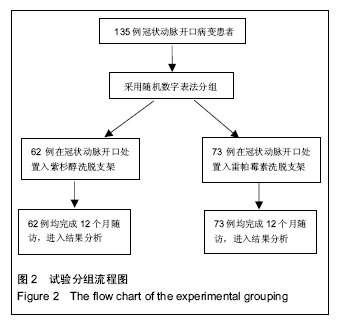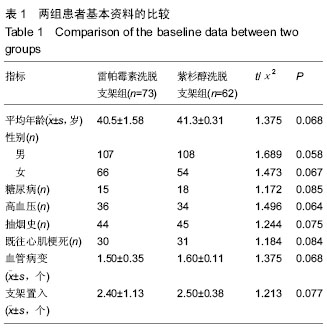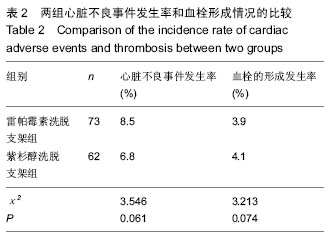| [1] 高正祥,罗兴林.药物洗脱支架防治再狭窄的研究进展[J].心血管病学进展,2007,28(2):269-272.
[2] 张立新,马长生,张海滨,等.国产雷帕霉素药物洗脱支架在冠状动脉分叉病变介入治疗中的应用[J].中国心血管病研究杂志,2007,5(2):121-123.
[3] 李惟铭,杨新春,王乐丰,等.糖尿病急性ST段抬高心肌梗死应用雷帕霉素药物洗脱支架1年随访分析[J].中国实用内科杂志,2007,27(13):1021-1022+1025.
[4] 许敏,郭金成,王国忠,等.国产药物洗脱支架对急性ST段抬高心肌梗死患者的疗效观察[J].中国心血管杂志, 2007, 12(5):366-368.
[5] 李惟铭,王乐丰,杨新春,等.急性ST段抬高心肌梗死小血管病变急诊经皮冠状动脉介入治疗应用雷帕霉素药物洗脱支架的疗效分析[J].中国急救医学, 2007,27(9):776-778.
[6] 刘如辉,赵明中,刘洋,等.急诊经皮冠状动脉介入治疗中应用雷帕霉素洗脱支架的疗效观察[J].中华全科医师杂志, 2007,6(12):731-733.
[7] 房凌海,英海荣,孙伟.雷帕霉素与紫杉醇洗脱支架置入冠状动脉预防心血管事件:有效性和安全性[J].中国组织工程研究,2015,19(8):1223-1227.
[8] 陈珏,陈纪林,乔树宾,等.雷帕霉素和紫杉醇药物洗脱支架治疗冠状动脉开口病变的临床疗效比较[J].中国循环杂志,2007,22(5):326-328.
[9] 高立建,陈俊,陈纪林.冠状动脉支架内血栓病理生理机制和临床研究进展[J].中国循环杂志,2007,22(5):396-398.
[10] 王向真,李丹,安毅.药物涂层支架的研究进展[J].心血管病学进展,2014,35(6):707-711.
[11] 卢妙,王向明,王森,等.不同药物洗脱支架置入老年急性非ST段抬高型冠脉综合征后的炎症因子反应[J].中国组织工程研究,2014,18(52):8414-8419.
[12] 陈纪林,杨跃进,黄静涵,等.冠心病真实世界中药物洗脱支架置入术后血栓形成的发生率[J].中华心血管病杂志, 2007, 35(12):1133-1135.
[13] 李亚,苏勇建,徐泽升.药物洗脱支架置入后再狭窄[J].心血管病学进展,2008,29(6):882-884.
[14] 王志军,柯元南.冠心病患者药物洗脱支架治疗研究进展[J].中国全科医学,2008,11(6):535-538.
[15] 郭奕彤,谭志刚.血管内支架材料特点与缺血性脑卒中的治疗效果[J].中国组织工程研究, 2013,17(12):2257-2264.
[16] 彭育红,汝磊生,王冬梅,等.国产无聚合物紫杉醇微孔载药支架与雷帕霉素涂层支架对比治疗急性心肌梗死[J].介入放射学杂志,2013,22(6):458-460.
[17] 嵇诚,张立新,高海明,等.Excel支架治疗冠心病合并糖尿病患者的安全性和有效性[J].河北医药, 2013,35(20): 3067-3069.
[18] 刘艳明,王雪芳.不同心血管支架材料对老年冠心病患者内皮素和血管再狭窄的影响[J]. 中国组织工程研究, 2012,16(3):535-538.
[19] 张智屏,葛华.抗血管平滑肌增生和迁移的药物涂层与支架置入后再狭窄[J].中国组织工程研究, 2012,16(12): 2245-2248.
[20] 郑玉华,周斌全,张峰,等.新型非对称、可降解涂层雷帕霉素洗脱支架用于行直接经皮冠状动脉介入治疗的急性心肌梗死患者的疗效和安全性[J].上海医学, 2012,35(1):44-47.
[21] 李涛,金鹏,李光南,等.紫杉醇微孔载药支架与进口雷帕霉素药物洗脱支架治疗冠心病的临床效果比较[J].心脏杂志,2012,24(3):358-360,369.
[22] 宁尚秋,刘文娴,韩静,等.不同药物洗脱支架治疗老年急性心肌梗死疗效观察[J].中华实用诊断与治疗杂志, 2012, 26(6):531-533.
[23] 随永刚,吴永健.药物洗脱支架内再狭窄研究进展[J].心血管病学进展,2012,33(4):474-477.
[24] 李平,姚光,陈坚,等.国产Firebird 2~(TM)与进口Endeavor-Sprint药物洗脱支架临床应用比较[J].广东医学,2012,33(12):1726-1728.
[25] 窦克非,尹栋,吴元,等.冠心病合并糖尿病患者置入雷帕霉素洗脱支架和紫杉醇洗脱支架长期有效性及安全性观察[J].中国循环杂志,2012,27(3):174-177.
[26] Sethi A,Bahekar A,Bhuriya R,et al.Drug-eluting stentsversus bare metal stents in ST elevation myocardial infarctionat a follow-up of three years or longer: A meta-analysis ofrandomized trials.Exp Clin Cardiol.2012;17(4):169-174.
[27] Jang SI,Kim JH,Kim M,et al.Porcine feasibility and safetystudy of a new paclitaxel-eluting biliary stent with aPluronic-containing membrane. Endoscopy. 2012; 44(9):825-831.
[28] Arroyave JC,Cepeda MC.Caracterización de la restenosis destents coronarios convencionalesy liberadores demedicamentos en pacientes incluidos en el registro Drug Eluting STent (DREST)/ Characterization of conventional coronary stents restenosis and drug eluting stents in patients included in the Drug Eluting Stent. Rev Colomb Cardiol. 2012;19(3):121-131.
[29] Chen JL,Gao LJ,Yang YJ,et al.Comparison of the incidence of late stent thrombosis after implantation of different drug-eluting stents in the real world coronary heart disease patients:three-year follow-up results.Chin Med J(Engl).2010;123(7):778-781.
[30] Atary JZ,van der Hoeven BL,Liem SS,et al.Three-year outcome of sirolimus-eluting versus bare-metal stents for the treatment of ST-segment elevationmyocardialinfaretion (from the MISSION [Intervention Study).Am J Cardiol. 2010;106(1):4-12.
[31] Violini R,Musto C,de Fellce F,et al.Maintenance of long-term clinical benefit with sirolimus-eluting stents in patients with ST-segment elevation myocardial infarction 3-year results of the SESAMI (sirolimus-eluting stent versus bare-metal stent in acute myocardial infarction) trial.J Am CoIl Cardiol. 2010;55(8):810-814.
[32] 尹栋,窦克非,杨跃进,等.冠状动脉慢性完全闭塞病变置入FIREBIRD雷帕霉素洗脱支架和TAXUS紫杉醇洗脱支架长期有效性及安全性观察[J].中国循环杂志, 2013,28(3): 172-175.
[33] 彭育红,汝磊生,王冬梅,等.国产无聚合物紫杉醇微孔载药支架与雷帕霉素涂层支架对比治疗急性心肌梗死[J].介入放射学杂志,2013,22(6):458-460.
[34] 郑心田,陈康寅,RHA Seung-Woon,等.不同药物洗脱支架在冠状动脉弥漫性长病变中的2年随访结果比较[J].中国介入心脏病学杂志,2013,21(6):354-357.
[35] 尹栋,窦克非,杨跃进,等.冠状动脉长病变患者置入雷帕霉素洗脱支架和紫杉醇洗脱支架2年临床观察[J].中国介入心脏病学杂志,2013,21(1):12-16.
[36] 宁尚秋,刘文娴,杨鲲,等.雷帕霉素洗脱支架与紫杉醇洗脱支架在急性心肌梗死直接经皮冠状动脉介入治疗中的疗效比较[J].临床荟萃,2012,27(8):660-66
[37] 胡琦,江洪,徐昌武,等.雷帕霉素药物洗脱支架与紫杉醇药物洗脱支架治疗冠心病疗效的Meta分析[J].中国循证心血管医学杂志,2012,4(3):199-203.
[38] Sethi A,Bahekar A,Bhuriya R,et al.Drug-eluting stentsversus bare metal stents in ST elevation myocardial infarctionat a follow-up of three years or longer: A meta-analysis ofrandomized trials.Exp Clin Cardiol.2012;17(4):169-174.
[39] 张兰,刘干,钟金鹏,等.国产无聚合物紫杉醇涂层支架和可降解聚合物雷帕霉素涂层支架治疗冠心病疗效评价[J].临床心血管病杂志,2011,27(7):494-498. |
.jpg)



.jpg)
.jpg)